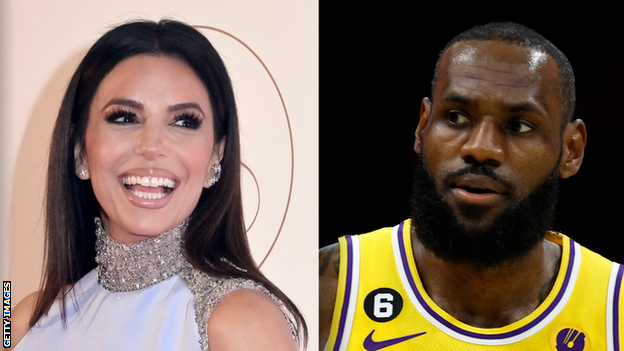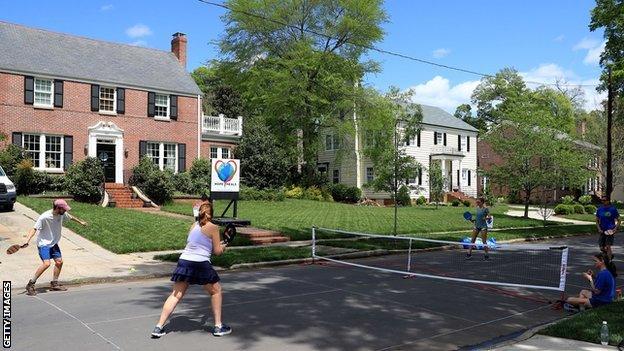The rise of pickleball & padel: helping tennis or threatening its existence?
- Published

Pickleball is attracting investment in professional teams - and publicity - from A-list celebrities including Desperate Housewives actress Eva Longoria and NBA star LeBron James
Venice Beach, Los Angeles.
The bohemian 'burb where seminal rock band The Doors lit their fire in the 1960s. Home to the bodybuilding boardwalk where Arnold Schwarzenegger began lifting his way towards superstardom in the 1970s.
It is an area which has always been seen as radical and unruly.
Now, nestled next to the Arnie-inspired weightlifters at Muscle Beach, among the thrift shops from where whiffs of incense and weed drift over, it is one of the places where you can often see the sporting craze creating a stir across the United States.
Pickleball.
Long seen as a leisurely recreation for older people, this hybrid of racquet sports boomed during the coronavirus pandemic and is the latest string-sibling to emerge from tennis' shadow.
Pickleball is the fastest-growing sporting activity in the US and the scenes of busy courts at Venice Beach - which have been predominantly used since the 1960s for paddle, another short-form game adapted from tennis - are being replicated across the nation.
"The tennis court is way too big and there's way too much ground to cover," says former Wimbledon junior champion Noah Rubin, who has switched from tennis' ATP Tour to take "a deep dive" into pickleball.
"I came across the pickleball court and, like so many others across the States, it clicked for me."
Combining elements of tennis, badminton and ping-pong, pickleball is played on a badminton-sized open court and with a lower net than tennis.
Players use solid paddles to hit a perforated and hollow ball, with the physics of the equipment limiting them to how hard and far they can whack it.
The smaller court means there is less running and more emphasis on hand skills.
One of pickleball's main marketing strands is stressing its fun and social benefits.
"You can play anywhere, you just need to throw down lines. It's a sport a nine-year-old can play or a 99-year-old can play," Rubin tells BBC Sport.
"There is nothing else like it. Pickleball is the most effortlessly accessible sport I've ever seen."

Pickleball, invented by Seattle politician Joel Pritchard and a group of friends in 1965, proved popular during coronavirus lockdowns
Almost five million people in the US played pickleball in 2021, according to research by the Sports and Fitness Industry Association (SFIA).
Over the past five years, the SFIA calculates the number of players has had an annual average growth of 11.5%.
Tennis, which has about 22.6 million players in the US, has seen an annual average growth of 4.9%.
"It is almost a cliche at this point that the pandemic did not so much create trends as much as accelerated them," says Tom Cove, president of the SFIA.
"Pickleball has grown in popularity for the past five years and did not miss a beat during the pandemic.
"Pickleball's growth trajectory gives every indication it will be a significant part of the American sport landscape for the foreseeable future."
From Eva Longoria to LeBron James - tapping into the power of celebrity
Pickleball is not just growing rapidly as a participation sport.
Tapping into the power of celebrity and using smart social media strategies have been key in growing it as a consumer sport.
The biggest, richest and most high-profile professional league - Major League Pickleball (MLP) - has been expanded to 24 teams and many are backed by A-list ownership groups.
Four-time Grand Slam tennis champion Naomi Osaka and Wimbledon runner-up Nick Kyrgios have invested in a new Miami-based team alongside NFL superstar Patrick Mahomes.
Another expansion consortium includes legendary NFL quarterback Tom Brady and four-time tennis major champion Kim Clijsters, while basketball superstars LeBron James and Kevin Durant, plus actress Eva Longoria and supermodel Heidi Klum, are also putting in money.
There will be six events across the US for the mixed-gender teams and the prize money pot has increased to $5m (£4.1m).
The commercial growth is also enticing professional tennis players to switch over.
Recently retired American Sam Querrey, who notably beat Andy Murray to reach the 2017 Wimbledon semi-finals, is the biggest-name convert and will play in the 2023 MLP.

MLP matches are comprised of four games (women's doubles, men's doubles and two mixed doubles), plus a 'Dreambreaker' singles tie-break where four players rotate after four points
Rubin, set to compete in his first professional tournament at an Association of Pickleball Professionals event in Florida this week, started playing after becoming disillusioned with the grind of the ATP Tour.
"I was slowing down, I was exhausted with my mental and physical wellbeing, I needed to take a real break from tennis," says the 26-year-old American.
"My first feeling towards pickleball was jealousy. I thought 'why is this new sport taking over a century-old sport that I've dedicated my life to?'
"Then I took a deep dive into what pickleball is and I saw incredible marketing capabilities.
"The sport allows a diverse range of people to be part of it at every level, allows the fans to get rowdy and have fun, while also allowing the professional players to have a brand. There are fewer restrictions.
"I think tennis' restrictions are a struggle for the next generation to understand and a barrier to them playing."
The 'war' escalates but racquet sports 'can co-exist'
Many people in the tennis community, fearing their sport is wrongly being painted as stuffy and out of date, feel threatened by pickleball's arrival.
There has been a backlash.
"I will never turn a TV on to watch pickleball. I would rather watch paint dry," tweeted Rennae Stubbs, the Australian doubles legend who was part of Serena Williams' coaching team at last year's US Open.
"Why all these tennis players think pickleball is worth investing in and not the game that made them all the [dollars] is beyond me."
Stubbs' views echoed the deep concern among some tennis communities that pickleballers are taking over their space.
A playground in New York City recently banned pickleball after what local media described as "months of conflict" between players and local parents.
The parents said their children were being driven away from the Seravalli Playground in West Village and forced action.
Allow X content?
This article contains content provided by X. We ask for your permission before anything is loaded, as they may be using cookies and other technologies. You may want to read X’s cookie policy, external and privacy policy, external before accepting. To view this content choose ‘accept and continue’.
It is one example of a turf war in the US which the Guardian recently said is "escalating"., external
"Inclusive and diverse tennis communities are getting smeared as stuffy and conservative so that their courts can be ripped up and replaced," said Club Leftist Tennis, a Brooklyn-based group.
In Europe, similar discussions are taking place around padel.
Often simplified as a mash-up of tennis and squash, padel is played with a perforated bat on an enclosed court.
The bat is smaller than a tennis racquet but weighs slightly more, while the ball has a lower pressure and slower bounce. The court is also smaller and about a third of a tennis court.
Like pickleball, there is more emphasis on technical skills than physicality. It also attracts a celebrity clientele, particularly among retired footballers.
Former England captain David Beckham recently declared his "love" for padel, France legend Zinedine Zidane had courts built at his football centre, while their old Real Madrid team-mate Ronaldo recently competed in a 'Legends' event during the World Cup in Qatar.
Even greater affirmation came from another superstar this week. Tennis legend Roger Federer, who retired from the sport last year, posted a series of photos and videos of him playing padel with his former coach Severin Luthi.
Allow X content?
This article contains content provided by X. We ask for your permission before anything is loaded, as they may be using cookies and other technologies. You may want to read X’s cookie policy, external and privacy policy, external before accepting. To view this content choose ‘accept and continue’.
Padel, developing into its modern guise in Mexico in 1969, is particularly popular in Spain and the nation has 20,000 courts, while tennis champions Rafael Nadal and Juan Carlos Ferrero have long incorporated it into their world-renowned academies.
In the UK, it is also starting to boom.
More than 200 courts have been built to serve about 90,000 active players with the Lawn Tennis Association believing padel can be a gateway into tennis, as well as continuing to grow in its own right.
Ferrero, who now coaches world men's tennis number one Carlos Alcaraz, agrees there is space in the racquet sport ecosystem for all the variants to thrive.
"I think they can coexist and make the other one improve," the 2003 French Open champion told BBC Sport.
"At my academy I see people going from tennis to padel, and also to start padel and then try tennis, and others that enjoy both.
"They are similar sports but their differences allow the athletes to find what adjusts better for their joy in each moment."

Can they identify The Traitors to win £120,000? Claudia Winkleman hosts a game of detection, backstabbing and trust
From Sex Education to SAS Rogue Heroes: Connor Swindells chats about his varied career
